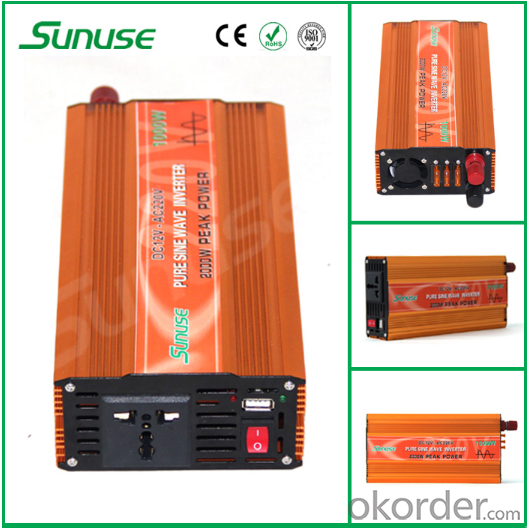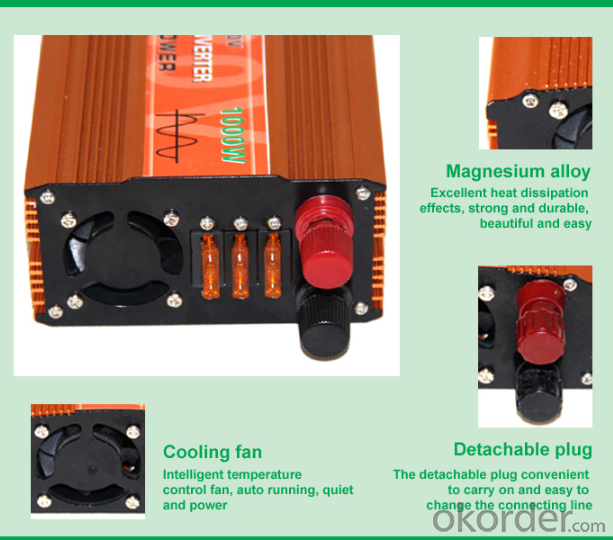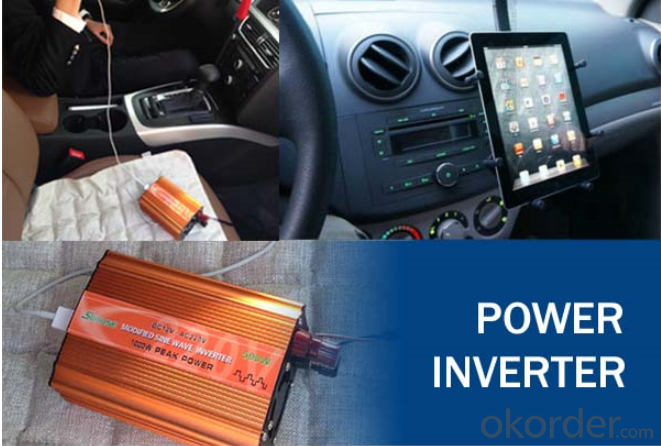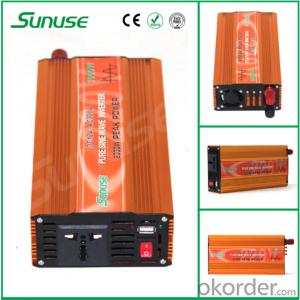Off Grid 1000W DC 12/24V to AC 110/220V Pure Sine Wave Inverter
- Loading Port:
- Qingdao
- Payment Terms:
- TT OR LC
- Min Order Qty:
- 50000 watt
- Supply Capability:
- 3000000 watt/month
OKorder Service Pledge
OKorder Financial Service
You Might Also Like
1. Structure of Off Grid 1000W DC 12/24V to AC 110/220V Pure Sine Wave Inverter Description
A solar inverter, or PV inverter, or Solar converter, converts the variable direct current (DC) output of a photovoltaic (PV) solar panel into a utility frequency alternating current (AC) that can be fed into a commercial electrical grid or used by a local, off-grid electrical network. It is a critical BOS–component in a photovoltaic system, allowing the use of ordinary AC-powered equipment. Solar inverters have special functions adapted for use with photovoltaic arrays, including maximum power point tracking and anti-islanding protection.
2. Main Features of the Off Grid 1000W DC 12/24V to AC 110/220V Pure Sine Wave Inverter
﹒convert 12V/24V DC to 220V/110V AC to supply for the electronic products such as player MP3, player MP4
﹒DC 12/24V to AC 110/220V
3. Off Grid 1000W DC 12/24V to AC 110/220V Pure Sine Wave Inverter Images




4. Off Grid 1000W DC 12/24V to AC 110/220V Pure Sine Wave Inverter Specification
Specifications: | |||
Type: | 1000W 12V | 1000W 24V | 1000W 48V |
Input DC Voltage Range: | 11-15V DC/22-31V DC/44-62V DC | 11-15V DC/22-31V DC/44-62V DC | 11-15V DC/22-31V DC/44-62V DC |
Under-voltage Protective: | 10.0±0.3V DC/20.0±0.8V DC | 10.0±0.3V DC/20.0±0.8V DC | 10.0±0.3V DC/20.0±0.8V DC |
Under-voltage Alarm: | 10.5±0.3V DC/21.0±0.8V DC | 10.5±0.3V DC/21.0±0.8V DC | 10.5±0.3V DC/21.0±0.8V DC |
Over Voltage Protective: | 16.0±0.3V DC/31.0±0.8V DC | 16.0±0.3V DC/31.0±0.8V DC | 16.0±0.3V DC/31.0±0.8V DC |
Over Voltage Recovery: | 15.0±0.3V DC/29.0±0.8V DC | 15.0±0.3V DC/29.0±0.8V DC | 15.0±0.3V DC/29.0±0.8V DC |
Max Power: | 1000W | ||
Peak Power: | 2000W | ||
USB: | 2000mA | ||
Reverse Protecion: | Blown fuses | ||
Over Load Protection Power: | 110%-120% | ||
Quiescent Current: | ≤0.4A | ||
Max. Efficiency: | ≥92% | ||
Total Harmonic Distortion: | ≤3% Linear load(pure sine wave) | ||
Status Indicator Lamp: | Work: Green LED Failure: Red LED and alarm LED Display: Voltage, Current, Power(optional) | ||
Usage: | for a car, truck, boat, home or standard battery; or solar system, etc. | ||
Work condition: | Operating Temperature: -10~40°C Opetating Humidity: 10--90%(non-condensate) | ||
5. FAQ of Off Grid 1000W DC 12/24V to AC 110/220V Pure Sine Wave Inverter
Q1. What is the difference between inverter and solar inverter?
A1. Inverter only has AC inpput, but solar inverter both connect to AC input and solar panel, it saves more power.
Q2. What is the difference between MPPT&PWM?
A2. MPPT has higher efficiency, it can track the max power point and won't waste energy.
Q3. What is the waranty of product?
A3. 12 months.
- Q:How is the efficiency of a solar inverter measured?
- The efficiency of a solar inverter is typically measured by calculating the ratio of the output power to the input power. This is done by dividing the AC power output by the DC power input, and then multiplying the result by 100 to obtain a percentage value.
- Q:How is a solar inverter different from a regular inverter?
- A solar inverter converts the direct current (DC) generated by solar panels into alternating current (AC) to be used in homes or fed back into the electric grid. In contrast, a regular inverter is typically used to convert DC power from batteries or other sources into AC power for general electrical use. The main difference lies in their purpose and the source of the DC power they convert.
- Q:What is the impact of a solar inverter on the overall system cost?
- A solar inverter can have a significant impact on the overall system cost. It is an essential component that converts the direct current (DC) produced by solar panels into alternating current (AC) that can be used by electrical appliances and fed into the grid. The quality and efficiency of the inverter play a crucial role in optimizing the energy production and overall performance of the solar system. High-quality inverters tend to be more expensive but can enhance the system's reliability, lifespan, and energy yield. Therefore, while a solar inverter does add to the system cost, investing in a reliable and efficient one can result in long-term benefits and returns by maximizing the system's overall performance.
- Q:Can a solar inverter be used for three-phase power systems?
- Yes, a solar inverter can be used for three-phase power systems. Three-phase solar inverters are specifically designed to convert the DC power generated by solar panels into AC power for three-phase electrical systems. These inverters are capable of handling the higher voltage and power requirements of three-phase systems, making them suitable for commercial and industrial installations.
- Q:Can a solar inverter be used in extreme weather conditions?
- Yes, solar inverters are designed to withstand a wide range of weather conditions, including extreme heat, cold, humidity, and even harsh environmental factors. They are built to be durable and reliable, ensuring their functionality and performance in various climates and weather conditions.
- Q:What is the role of a power backup system in a solar inverter?
- The role of a power backup system in a solar inverter is to provide a reliable source of energy during periods of low or no sunlight. This backup system, usually in the form of batteries, stores excess energy generated by the solar panels and allows it to be used when the solar energy production is insufficient or unavailable. It ensures a continuous and uninterrupted power supply, even during grid outages or at night, making the solar inverter system more reliable and versatile.
- Q:What is the difference between a string inverter and a microinverter?
- A string inverter is a centralized device that converts the direct current (DC) generated by a solar panel array into alternating current (AC) for use in a building or grid. It is typically connected to a string of solar panels, where multiple panels are wired together in series. On the other hand, a microinverter is a small inverter that is attached to each individual solar panel, converting the DC power generated by each panel into AC power. The main difference between the two is their level of integration and connectivity. While a string inverter handles the conversion for multiple panels, a microinverter enables independent operation and optimization of each panel, resulting in increased energy harvest, system flexibility, and fault tolerance.
- Q:How does shade affect the performance of a solar inverter?
- Shade has a significant impact on the performance of a solar inverter. When a solar panel is partially shaded, it reduces the amount of sunlight reaching the panel, resulting in a decrease in power generation. This leads to a decrease in the overall performance of the solar system, as the inverter's efficiency is directly linked to the amount of power it receives from the panels. Additionally, shade can also cause voltage fluctuations and imbalances, potentially damaging the inverter. Therefore, avoiding shade and ensuring unobstructed sunlight is crucial for optimal performance of a solar inverter.
- Q:What are the common maintenance requirements for a solar inverter?
- Common maintenance requirements for a solar inverter typically include regular cleaning to remove dust and debris, checking and tightening electrical connections, inspecting for any signs of damage or wear, monitoring performance and output, and updating software or firmware as needed. Additionally, it is important to follow the manufacturer's guidelines and recommendations for maintenance to ensure optimal functionality and longevity of the solar inverter.
- Q:Can a solar inverter be used with a solar air conditioning system?
- Yes, a solar inverter can be used with a solar air conditioning system. A solar inverter is responsible for converting the direct current (DC) electricity produced by solar panels into alternating current (AC) electricity that can be used to power household appliances, including air conditioning systems. By connecting a solar inverter to a solar air conditioning system, the energy generated by the solar panels can be efficiently utilized to cool the environment. This not only maximizes the use of renewable energy but also helps in reducing electricity costs and minimizing the carbon footprint.
1. Manufacturer Overview |
|
|---|---|
| Location | |
| Year Established | |
| Annual Output Value | |
| Main Markets | |
| Company Certifications | |
2. Manufacturer Certificates |
|
|---|---|
| a) Certification Name | |
| Range | |
| Reference | |
| Validity Period | |
3. Manufacturer Capability |
|
|---|---|
| a)Trade Capacity | |
| Nearest Port | |
| Export Percentage | |
| No.of Employees in Trade Department | |
| Language Spoken: | |
| b)Factory Information | |
| Factory Size: | |
| No. of Production Lines | |
| Contract Manufacturing | |
| Product Price Range | |
Send your message to us
Off Grid 1000W DC 12/24V to AC 110/220V Pure Sine Wave Inverter
- Loading Port:
- Qingdao
- Payment Terms:
- TT OR LC
- Min Order Qty:
- 50000 watt
- Supply Capability:
- 3000000 watt/month
OKorder Service Pledge
OKorder Financial Service
Similar products
New products
Hot products
Hot Searches
Related keywords






























